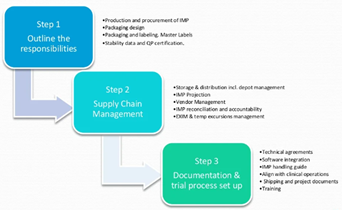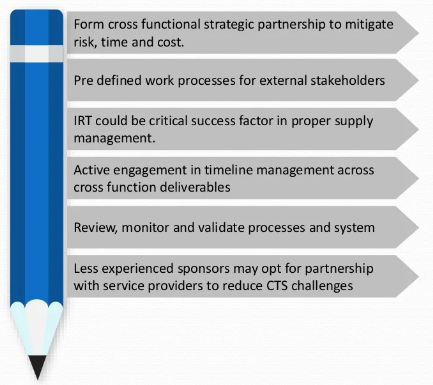Things to consider and how to ease the process
IMP Supply Management is a journey where GMP meets GCP and GDP. This journey includes finance, flow of products and documentation. How a company manages this flow can be referred to as IMP Supply (Chain) Management. The key objective is to Get The Right Drug To The Right Patient In The Right Time and Condition. IMP Supply Management is the management of operations that are involved in the procurement of raw materials, its processing of finished goods and distribution to the patient. See Figure 1 below.

Why Consider a Robust Clinical Drug Supply Chain?
With the expansion of global services, ever-changing regulations, and patient focus at top of mind, it is paramount that identifying potential obstacles in the delivery of drug are recognized and managed as early and quickly as possible.
How hard can it be? Unfortunately, weakness in the drug supply chain can be anywhere and can be easily underestimated. The end goal is to deliver safe and effective drug to patients in a timely manner. As there are many posing threats to the Pharmaceutical Supply Chain, it has become more prevalent for companies to engage specialists and partners who can focus on developing an effective supply chain system. ProPharma Group is here to help!
This Blog highlights key areas where ProPharma Group can support clients in risk mitigation, reducing long-term costs, reducing lead times, and minimizing errors by developing a robust Supply Chain Strategy.
Logistics
Logistics is a broad area of expertise within Supply Management which encompasses many areas of knowledge and best practices. A logistical plan of where to develop, how to produce and deliver drug to patients should be done in the early stages of the supply chain strategy plan.
- Single-Center versus Multi-Center Trial
- Practice of Pharmacy (prescription) vs. cGMP Processing (Batch Record)
- Sourcing of Materials, Study Drug, Ancillaries, etc.
- API, Bulk Drug Product, Packaged Drug Product
- Labelling – Blinded versus Open Label
- Packaging – Primary and Secondary
- Storage Condition Considerations
- Frozen, Refrigerated, Room Temperature, Light Sensitive, Moisture Sensitive
- Distribution Logistics
- Transportation of supplies that are temperature sensitive may require special In-Transit temperature controls and monitoring
- Warehouse & Site Management
Most sites have limited storage capabilities – Planning of initial and restock supplies with time constraints in mind
Import and Export Regulations
Rules and Regulations of import/export of IMP and CTM vary from country to country. Supply Chain supports process-related issues to navigate challenging import and export requirements by collaborating with Regulatory and local vendors. Knowing how, when, and what documentation to prepare in case of Import/Export prior to the transfer of drug supply reduces frustration and can prevent fines and reduce lead times.
- Import procedures & Export procedures
- Shipping Documentation
- Taxes and additional duties
- Tariffs
- Rules of Origin
- Product Requirements
- Trade Barriers
Forecasting for Resupplies and Lead Time (Months!)
The most under-estimated area in supply planning is Lead Time. The amount of time it can take to source, manufacture, produce, and distribute a product to the end user can be several months. Timelines are crucial and top of mind when the goal is to help patients in need. Managing forecast versus demand, schedule changes, fluctuations in costs, and unexpected logistical issues can arise.
What to factor in:
| Forecasting Resupply | Lead Times |
| Expiry / Retest Dates | Time to receive API and all required excipients |
| Storage constraints at vendor | Time to receive components |
| Leadtime / Costs to manufacture batches | Time for Manufacturing (including getting in the manufacturing Queue) |
| Transportation / Customs costs for multiple shipments | Primary and Secondary packaging |
| Quantities to Order | Labelling |
| Distribution to Sites |
Packaging & Labelling
Packaging and labelling are two important parts of pharmaceutical products. Labelling is not only important for patient safety, but also correct labeling can help pharmacies avoid errors in relation to the storage of medicinal products. The obvious consequence of incorrect labelling is that a patient ends up with the wrong medicine or the wrong dose. In an extreme case, this could cause serious harm or even result in death of the patient. It is also important to avoid long lead-times and high costs. The design, ordering materials and having respect for lead-times while ensuring the label text is reviewed by minimum two people is important. Some factors to consider when deciding packaging & labelling design:
- Blinded vs Open-Label design
- Kit Label
- Bottle / Blister / Vial
- Package Leaflet
- Just-in-Time Labelling (JTL)
- Blinded dosing regimen
- Blinded Titration Phase
Training & Certifications
GMP Training
- FDA regulations require anyone involved in the manufacturing, processing, packing, and holding of a product to have education, training, and experience to perform their assigned functions. These individuals also need training on general GMP requirements, particularly those related to their job functions. During the Vendor Selection process, utilizing GMP compliant contract manufacturing organizations (CMO) and assuring robust supply chain with dependable lead times will reduce deviations and add to your cost saving targets.
GDP Training
- All employees involved in the distribution of medicinal products need to be trained to comply with the requirements defined Good Distribution Practices Guidelines. In GDP, there is more detail pertaining to the picking, supply, and export of stock.
Summary
Challenges are unavoidable within Drug (IMP) Supply Chain, but clients can count on ProPharma Group to guide and support them through such challenges by implementing best practices and a supply chain strategy that can best handle their specific target and patient needs. Contact us today to connect with our team and tell us how we can help you achieve your goals.
